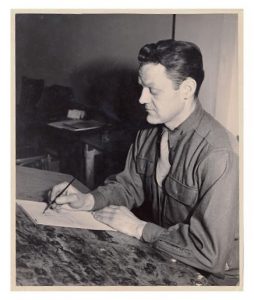
Soldier in the Field
Paris has acquired a reputation as the “City of Art.” But as war was declared on September 3, 1939, the Louvre evacuated its collections, sandbagged the larger pieces it couldn’t move and closed for business. In 1940, the invading German forces reopened the museum, but visitors found a mostly empty building. With hope brought by the Allied success at Normandy in June of 1944, the liberation of Paris seemed inevitable. Freeing the city from its Nazi occupiers would be a massive morale boost to the French. However, it was not seen as a high priority for Allied leaders. General Dwight D. Eisenhower did not want to be perceived as interfering in French affairs, but the uprising of the Parisian people on August 19th changed his plans.

Gun & Army Pack
On August 22, 1944, Eisenhower wrote to Army Chief of Staff General George C. Marshall to explain that it would be desirable to defer the capture as long as possible, but that if the Germans held Paris, they would be a menace to the Allied troops bypassing the capital. Marshall replied that intelligence reports did not feel that “the Paris-Orleans German assembly has the capability for a counterattack.” And so less than three months after D-Day, the French 2nd Armored Division and the U.S. 4th Infantry Division liberated Paris from four years of Nazi occupation. While not a significant military victory for the Allied forces, Time reported “the news that made the whole free world catch its breath last week was the news that Paris was free.” With the liberation of the city, the European Theater of Operations found a home in Paris, and with it was George Withers.

George Withers, ETO, Paris
George Withers was a leading American illustrator whose work appeared in such prominent publications as The Saturday Evening Post and Colliers as well as in newspapers and on billboards across the country, since the 1930s. During World War II, he served as an artist for the Army. While in Paris, he produced magazine covers and illustrations for Stars and Stripes and Army Talks. He also sent his family illustrated letters, watercolors and pen and ink drawings of Parisians, American soldiers and the sights in the city. For his contribution to the military he received personal letters of thanks from Generals Dwight D. Eisenhower and Lucius Clay.
Withers’ collection at the George C. Marshall Foundation consists of 10 watercolors that he completed while in the Army. Liberated Paris may have inspired his piece “Soldier Thinking,” a scene on a Parisian street where an American soldier is caught in a moment of reflection.

Solider Thinking
